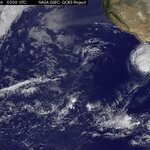Atmospheric

The Miocene climatic optimum, was a period from about 15 to 17 million years ago and it had wild swings in temperature, the amount of continental ice on the planet and CO2 levels.
Historically, CO2 had inconsistent relationships to temperature. When levels were 10X higher than they are now, the temperature was 2 degrees higher. What has been lacking is a solid relationship between them outside the last few decades and a new paper in Paleoceanography finds that during the
Miocene climatic optimum has found that these changes in temperature and ice volume were matched by equally…
During the 1930s, North America endured what came to be called the Dust Bowl, a prolonged era of dryness - the worst drought in America of the last 1,000 years - that withered crops and dramatically altered where the population settled.
80 years ago, in 1934, is when things really got crazy; giant dust storms and drought covered more than 75 percent of the country and affected 27 states severely.
Land-based precipitation records from the years leading up to the Dust Bowl are consistent with the telltale drying-out period associated with a persistent dry weather pattern, but they can't…

A high amount of methane, the main component of natural gas, is escaping from the Four Corners region in the U.S. Southwest, according to a new study.
Four Corners sits on North America's most productive coalbed methane basin. Coalbed methane is a variety of the gas that's stuck to the surface of coal. It is dangerous to miners - canaries in the coal mine is a famous saying - but a valuable clean energy resource and the reason CO2 emissions have dropped.
Since carbon dioxide emissions have dropped in the US, that methane, which is much shorter-lived but 23X the warming effect of CO2,…

Tropical Storm Simon, once a hurricane, is expected to bring heavy rain to portions of the central Plains and Midwest on today and tomorrow. Since it is not hitting New York City during presidential election season, it won't be called a SuperStorm and get much national media attention.
Images from NOAA's GOES-East satellite from Oct. 6 through Oct. 9 were made into a 39 second animation by the NASA/NOAA GOES Project at NASA's Goddard Space Flight Center in Greenbelt, Maryland. The animation shows Simon as a Tropical Storm in the Eastern Pacific Ocean on Oct. 6 when it was located off the…

Tropical Cyclone Hudhud formed on Oct. 8th and began moving from east to west across the Bay of Bengal in the Northern Indian Ocean.
NASA's Aqua satellite flew over Hudhud today and took a picture of the storm that showed it was still somewhat elongated, but more organized than the previous day. The Moderate Resolution Imaging Spectroradiometer (MODIS) instrument aboard NASA's Aqua satellite provided the hint of a developing eye.
Warnings for winds, rain and surf are already in effect for the northern Andhra Pradesh coast and south Odisha coastline of eastern India as Hudhud approaches…

The NASA satellites, Tropical Rainfall Measuring Mission (TRMM) and Terra, have provided data on clouds, rainfall and the diameter of the eye of Super Typhoon Vongfong as it turned north in the Northwestern Pacific Ocean.
Typhoon Vongfong formed on October 2nd, 2014 in the southeast of Guam. Typhoon Phanfone, that recently pummeled Japan, formed near the same area in the western Pacific Ocean.
Vongfong had wind speeds of about 120 knots (138 mph) when the TRMM satellite flew above the intensifying typhoon's eye on October 7th, 2014 at 0800 UTC (4 a.m. EDT). TRMM's Precipitation Radar (PR…

Image: Genetic Literacy Project
By Tabitha M. Powledge, Genetic Literacy Project
Around the world, average temperatures have increased 0.69°C in the past century. In Japan, temperatures have increased 1.15°C in that time. A new Japanese study suggests that climate change could be causing the deaths of male fetuses and reducing the number of boy babies born. The Japanese scientists report an association between warmer temperatures and the number of spontaneous abortions of male fetuses since the 1970s.
The normal human sex ratio—the number of males in a particular population compared to the…

Almost 20 percent of the Earth's atmosphere is oxygen. Green plants produce it as a byproduct of photosynthesis and it, in turn, is used by most living things on the planet to keep our metabolisms running.
Yet before those photosynthesizing organisms appeared about 2.4 billion years ago, the atmosphere was mostly carbon dioxide, a lot like Mars and Venus.
The common hypothesis is that there must have been a small amount of oxygen in the early atmosphere. Where did this abiotic ("non-life") oxygen come from? Oxygen reacts quite aggressively with other compounds, so it would not persist…

Though the Intergovernmental Panel on Climate Change (IPCC) has asked climate scientists not to attribute weather conditions to climate change, a new paper is doing just that.
A team writing in the Bulletin of the American Meteorological Society says that the atmospheric conditions associated with the unprecedented drought currently afflicting California are "very likely" linked to human-caused climate change.
Stanford climate scientist Noah Diffenbaugh and colleagues based their claim on numerical models and statistical techniques and conclude that a persistent region of high…

NASA's Aqua satellite captured strong thunderstorms with colder cloud tops that have grown within Tropical Storm Rachel in the Eastern Pacific Ocean.
Aqua passed over the large Tropical Storm Rachel on Sept. 25 at 4:41 p.m. EDT and the Atmospheric Infrared Sounder or AIRS instrument, saw that the extent of colder cloud tops had increased, indicating thunderstorm heights were increasing and it was strengthening. The expansion of those stronger thunderstorms also suggests that the northeasterly wind shear may be relaxing a little. The strongest thunderstorms remain limited to the southwest of…